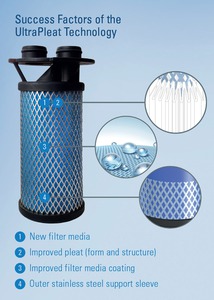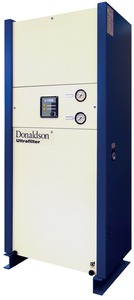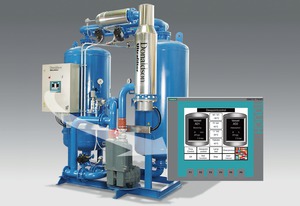

|
Edward Lowton
Editor |


|
ARTICLE
Energy efficiency of compressed air filters increased by new filtration technology: 50% reduction in differential pressure with UltraPleat® technology
14 August 2014
50% reduction in differential pressure with UltraPleat® technology in comparison to the previous series.
The differential pressure in filtering compressed air and technical gases is now being reduced by 50%, thanks to a new filtration technology. This extremely favorable performance that engineers at Donaldson were able to achieve by developing their new UltraPleat® filtration technology will have a great effect on the energy consumption of compressors. Because compressed air is used in over 90% of production plants, compressed air filter elements make a significant contribution to the reduction of electricity costs in many areas of various industries.
UltraPleat® filtration technology uses a new structure of coated high-tech fibres that are processed into a pleated filter medium with a high separation efficiency of liquid particles and a huge adsorption capacity for solid particles. The multilayer structure of the new filter medium was designed so that optimal aerodynamic conditions are achieved, simultaneously providing a filter surface that is over 400 % larger by comparison with wrapped filter media. For the separation of oil aerosols, an efficiency of ≥ 99.9% in accordance with ISO12500-1 is achieved. The filter performance data in compliance with ISO12500-1 and ISO12500-3 have also been validated by an independent institute for energy and environmental research. The fact that this high filtration performance was achieved while reducing differential pressure by a further 50% in comparison to the former range, highlights the successful development of Donaldson filtration technology in increasing energy efficiency and resource conservation (Fig. 1).
The use of this new technology is worthwhile for compressed air users, as can be seen from an example based on an Ultra-Filter DF-S1100 UltraPleat compressed air filter. If operated for 8,000 hours at a flow rate of 1,000 m³/h with the permissible operating pressure of 7 bar, a reduction in differential pressure of 190 mbar down to only 180 mbar results, measured in an oilwetted condition. This corresponds to an annual energy cost saving of approximately £1,217, assuming an electricity price of 7 pence/kWh.
The real impact that a compressed air filter with low flow resistance has on the energy consumption becomes clear when considering that – on average – two filters are used for the treatment of compressed air produced by one compressor. In European industry, around 320,000 compressors consume about 80 billion kilowatt hours per annum in the generation of compressed air, which represents around 10% of industrial electricity demand1, costing industry about £5.3 billion at electricity price of 7 pence per kWh. On the basis of the utility power plant mix, the environment is negatively impacted by 47.2 million tons of CO2.
The rapid availability of compressed air filter elements and components is an important aspect to the trade and users of compressed air. All popular sizes and types of filters are available from stock. Orders received by 1 pm will usually be shipped the same day and a comprehensive service network provides on-site maintenance of compressed air treatment systems and offers advice to customers.
Energy efficient drying of the compressed air
The adsorption drying technology is just as important as the filtration technology. Tailored systems offer economic and efficient processing for the user. Adsorption dryers are the right choice if very low residual moistures or pressure dew points below 0°C are required. Basically a difference must be made between two types: heatless- and heat-regenerating adsorption dryers.
Heatless adsorption dryers are predominantly used for smaller power ranges. For example, the series Ultrapac® Classic is used to process amounts of compressed air starting already at 5 m³/h.
In total, the range of performance of this series goes up to 35,000 m³/h. As regards heat-regenerating systems, various types with external and internal generation of the regeneration heat are available for performance ranges of up to 80 000 m³/h (Fig. 2). Plants that use the existing waste heat of compressors, for example, or the process heat for regeneration are particularly economic. In this case individual engineering is always required, which, however, pays off for the user because the energy costs and, consequently, the life cycle costs can clearly be reduced. Before investing in a new compressed-air system, the user should first check whether a standard adsorption dryer or an individual solution would be better for him.
Control engineering – optimum understanding between human and machine The control engineering used in the adsorption dryers is pointing the way ahead. It informs the user about the operating condition of the dryer. The transparency of the human-machine interface is further increased due to the standard design with touch panels. This applies to all heat-regenerating adsorption dryers in the series HRE, HRG, HRS, HRS-L and HRC as well as for the tailored system solutions (Fig. 3). This multi-lingual HMI interface (human-machine interface) provides the user with all relevant operating data at a glance. The high operating convenience is reached by the self-explanatory menu guidance, the clear display of the current operating condition and the easy adjustment of the operating parameters to the specific application conditions. For the export-oriented plant engineering, these modern and user-friendly control units are just as important as the competent and comprehensive Donaldson service, which guarantees the initial start-up and maintenance of the sophisticated dryer system solutions.
1 Peter Radgen, Edgar Blaustein "Compressed Air Systems in the European Union"/Fraunhofer ISI Press Release
Figure 1: The new Donaldson UltraPleat® technology reduces the differential pressure of the filter and increases energy efficiency
Figure 2: The Ultrapac Classic adsorption dryer for economic compressed air drying and easy to maintain
Figure 3: The standard touch panel for heatless adsorption dryers provides a high degree of operating convenience.
MORE FROM THIS COMPANY
RELATED ARTICLES
- Food and beverage grade air: Best practice guidelines
- Efficient compressed air generation – and heat for free
- Controlling water contamination
- The changing face of compressed air specification
- Ensuring that safety is paramount
- Trade association: Membership gains
- Training initiatives: An air of confidence
- The ongoing need to compress energy usage
- Bacteria and condensate
- Quick-win savings: Potential pitfalls
OTHER ARTICLES IN THIS SECTION




















